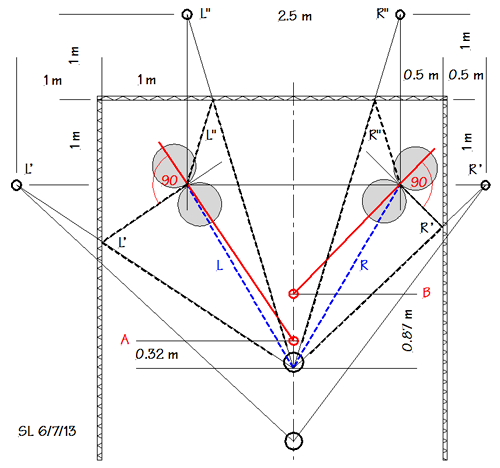The importance of symmetry in terms of equal distance of the loudspeakers from the side walls derives from the fact that what one hear is not just the direct sound of the speakers but also the reflections from the room walls. Especially important are the first wave reflections for they contribute to the spatial quality of the stereo image and its tonal richness.
Getting rid of the reflected sound waves by applying absorption is not the way to go, especially when it comes to side wall reflections, because they have a positive impact on the perception of space. During the audio post production symmetrical speaker setup is used, therefore symmetry becomes precondition for proper stereo imaging.

Having the audio system gravitating towards one of the side walls would increase the level of the sound it reflects and reduce the arriving time of the wave at the listening spot. This could result in twisted and not realistic images. Room limitations are something we cannot avoid completely, but have to figure out ways to minimise their negative impact while preserving the room domestic functions intact.
I am interested in the topic for my listening room situation is non-symmetrical, meaning that the left speaker is much closer to the side wall compared to the other. Luckily the situation in my room is not as bad as one could suggest because the closest side wall has a diffusive character — it has alcove windows and radiators protruding out of it. This unevenness of the wall surface helps to break the wave uniformity. There are curtains too which, by means of reducing the acoustic energy, act as absorbers. So by utilising diffusion and absorption the negative impact imposed by the lack of symmetry has been decreased.
While researching the topic I stumbled upon an interesting article on Linkwitz Lab expressing opinions on how to minimise the damaging effects of non-symmetrical audio system setups on stereo imaging. Linkwitz suggests that more toe-in is required for the speaker that is closer to the side wall. In short: the optimum amount of toe-in is a function of loudspeaker distance from the side walls and distance to the listener.

Currently my speakers are pointed straight ahead having 0 toe-in. This gives me very nice balance and tonality and widens the sweet spot so that a stable and centered image could be enjoyed from all 3 seats on my sofa. I tried the Linkwitz experiment applying a slight toe-in angle to my left speaker and I have to say that it did work. But the devil is as usually in the details, so the right amount of toe-in is crucial. When slightly overdosed, it narrows the sweet spot the listeners might enjoy. Having around 1.5 – 2 degree toe-in angle on the left speaker and 0 degree on the right speaker, in my room I could detect an increasement of the soundstage dimensions further beyond the closest wall boundary.
Yesterday while I was watching the latest episode of “Tatort” which is kind of a cult TV series here in Germany, characterised by its outstanding sound engineering work, I was struck by the 3d rendering of the ambient sounds which have gained new level of palpability and realism. Ambient sounds were popping out from behind and further out of the room boundaries. I haven’t noticed such a prominent 3d presentation before introducing the slight asymmetry in the toe-in angle suggested by Linkwitz.
In short, what I learned in this case is that striving for symmetry in an asymmetrical setup does not necessarily lead to the best results.
Cheers!
